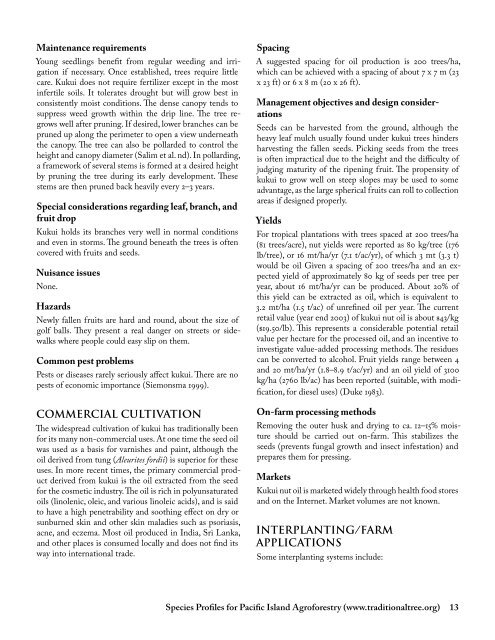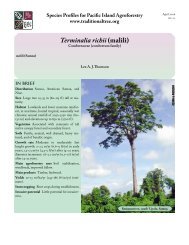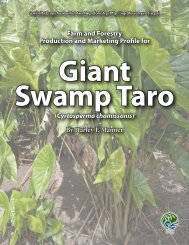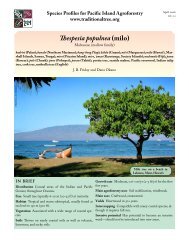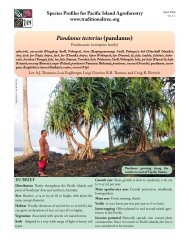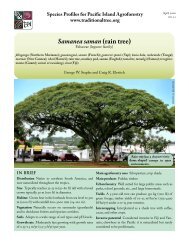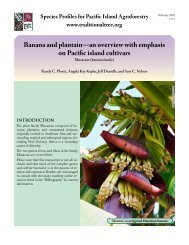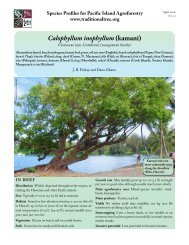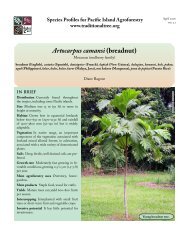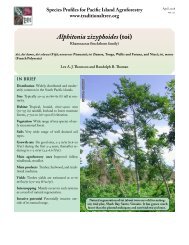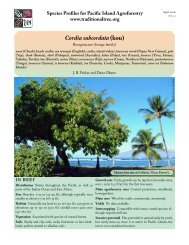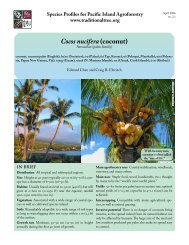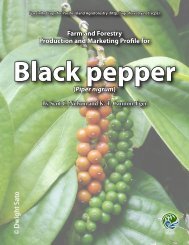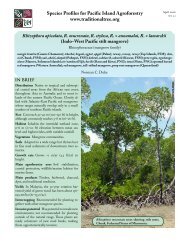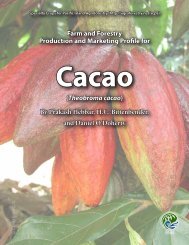Aleurites moluccana (Kukui) - Agroforestry Net
Aleurites moluccana (Kukui) - Agroforestry Net
Aleurites moluccana (Kukui) - Agroforestry Net
You also want an ePaper? Increase the reach of your titles
YUMPU automatically turns print PDFs into web optimized ePapers that Google loves.
Maintenance requirements<br />
Young seedlings benefit from regular weeding and irrigation<br />
if necessary. Once established, trees require little<br />
care. <strong>Kukui</strong> does not require fertilizer except in the most<br />
infertile soils. It tolerates drought but will grow best in<br />
consistently moist conditions. The dense canopy tends to<br />
suppress weed growth within the drip line. The tree regrows<br />
well after pruning. If desired, lower branches can be<br />
pruned up along the perimeter to open a view underneath<br />
the canopy. The tree can also be pollarded to control the<br />
height and canopy diameter (Salim et al. nd). In pollarding,<br />
a framework of several stems is formed at a desired height<br />
by pruning the tree during its early development. These<br />
stems are then pruned back heavily every 2–3 years.<br />
Special considerations regarding leaf, branch, and<br />
fruit drop<br />
<strong>Kukui</strong> holds its branches very well in normal conditions<br />
and even in storms. The ground beneath the trees is often<br />
covered with fruits and seeds.<br />
Nuisance issues<br />
None.<br />
Hazards<br />
Newly fallen fruits are hard and round, about the size of<br />
golf balls. They present a real danger on streets or sidewalks<br />
where people could easy slip on them.<br />
Common pest problems<br />
Pests or diseases rarely seriously affect kukui. There are no<br />
pests of economic importance (Siemonsma 1999).<br />
COMMERCIAL CULTIVATION<br />
The widespread cultivation of kukui has traditionally been<br />
for its many non-commercial uses. At one time the seed oil<br />
was used as a basis for varnishes and paint, although the<br />
oil derived from tung (<strong>Aleurites</strong> fordii) is superior for these<br />
uses. In more recent times, the primary commercial product<br />
derived from kukui is the oil extracted from the seed<br />
for the cosmetic industry. The oil is rich in polyunsaturated<br />
oils (linolenic, oleic, and various linoleic acids), and is said<br />
to have a high penetrability and soothing effect on dry or<br />
sunburned skin and other skin maladies such as psoriasis,<br />
acne, and eczema. Most oil produced in India, Sri Lanka,<br />
and other places is consumed locally and does not find its<br />
way into international trade.<br />
Spacing<br />
A suggested spacing for oil production is 200 trees/ha,<br />
which can be achieved with a spacing of about 7 x 7 m (23<br />
x 23 ft) or 6 x 8 m (20 x 26 ft).<br />
Management objectives and design considerations<br />
Seeds can be harvested from the ground, although the<br />
heavy leaf mulch usually found under kukui trees hinders<br />
harvesting the fallen seeds. Picking seeds from the trees<br />
is often impractical due to the height and the difficulty of<br />
judging maturity of the ripening fruit. The propensity of<br />
kukui to grow well on steep slopes may be used to some<br />
advantage, as the large spherical fruits can roll to collection<br />
areas if designed properly.<br />
Yields<br />
For tropical plantations with trees spaced at 200 trees/ha<br />
(81 trees/acre), nut yields were reported as 80 kg/tree (176<br />
lb/tree), or 16 mt/ha/yr (7.1 t/ac/yr), of which 3 mt (3.3 t)<br />
would be oil Given a spacing of 200 trees/ha and an expected<br />
yield of approximately 80 kg of seeds per tree per<br />
year, about 16 mt/ha/yr can be produced. About 20% of<br />
this yield can be extracted as oil, which is equivalent to<br />
3.2 mt/ha (1.5 t/ac) of unrefined oil per year. The current<br />
retail value (year end 2003) of kukui nut oil is about $43/kg<br />
($19.50/lb). This represents a considerable potential retail<br />
value per hectare for the processed oil, and an incentive to<br />
investigate value-added processing methods. The residues<br />
can be converted to alcohol. Fruit yields range between 4<br />
and 20 mt/ha/yr (1.8–8.9 t/ac/yr) and an oil yield of 3100<br />
kg/ha (2760 lb/ac) has been reported (suitable, with modification,<br />
for diesel uses) (Duke 1983).<br />
On-farm processing methods<br />
Removing the outer husk and drying to ca. 12–15% moisture<br />
should be carried out on-farm. This stabilizes the<br />
seeds (prevents fungal growth and insect infestation) and<br />
prepares them for pressing.<br />
Markets<br />
<strong>Kukui</strong> nut oil is marketed widely through health food stores<br />
and on the Internet. Market volumes are not known.<br />
INTERPLANTING/FARM<br />
APPLICATIONS<br />
Some interplanting systems include:<br />
Species Profiles for Pacific Island <strong>Agroforestry</strong> (www.traditionaltree.org) 1


